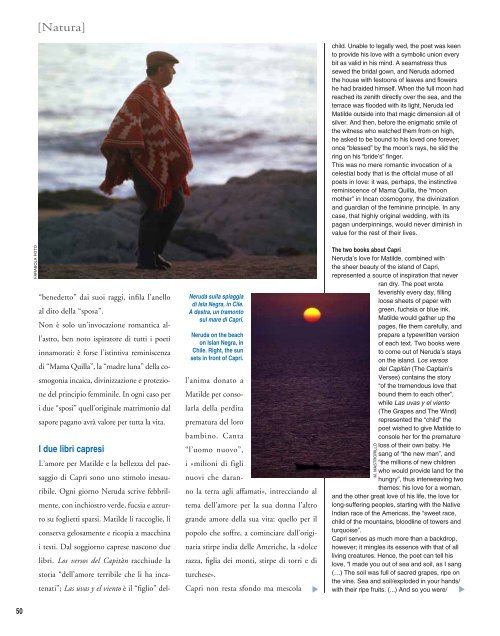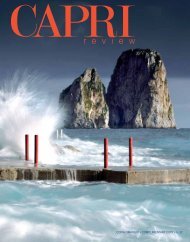COPIA OMAGGIO ⢠COMPLIMENTARY COPY EDIZIONI PRC
COPIA OMAGGIO ⢠COMPLIMENTARY COPY EDIZIONI PRC
COPIA OMAGGIO ⢠COMPLIMENTARY COPY EDIZIONI PRC
You also want an ePaper? Increase the reach of your titles
YUMPU automatically turns print PDFs into web optimized ePapers that Google loves.
[Natura]<br />
FARABOLA FOTO<br />
Neruda sulla spiaggia<br />
di Isla Negra, in Cile.<br />
A destra, un tramonto<br />
sul mare di Capri.<br />
Neruda on the beach<br />
on Islan Negra, in<br />
Chile. Right, the sun<br />
sets in front of Capri.<br />
l’anima donato a<br />
Matilde per consolarla<br />
della perdita<br />
prematura del loro<br />
bambino. Canta<br />
“l’uomo nuovo”,<br />
i «milioni di figli<br />
nuovi che daranno<br />
la terra agli affamati», intrecciando al<br />
tema dell’amore per la sua donna l’altro<br />
grande amore della sua vita: quello per il<br />
popolo che soffre, a cominciare dall’originaria<br />
stirpe india delle Americhe, la «dolce<br />
razza, figlia dei monti, stirpe di torri e di<br />
turchese».<br />
Capri non resta sfondo ma mescola<br />
<br />
“benedetto” dai suoi raggi, infila l’anello<br />
al dito della “sposa”.<br />
Non è solo un’invocazione romantica all’astro,<br />
ben noto ispiratore di tutti i poeti<br />
innamorati: è forse l’istintiva reminiscenza<br />
di “Mama Quilla”, la “madre luna” della cosmogonia<br />
incaica, divinizzazione e protezione<br />
del principio femminile. In ogni caso per<br />
i due “sposi” quell’originale matrimonio dal<br />
sapore pagano avrà valore per tutta la vita.<br />
I due libri capresi<br />
L’amore per Matilde e la bellezza del paesaggio<br />
di Capri sono uno stimolo inesauribile.<br />
Ogni giorno Neruda scrive febbrilmente,<br />
con inchiostro verde, fucsia e azzurro<br />
su foglietti sparsi. Matilde li raccoglie, li<br />
conserva gelosamente e ricopia a macchina<br />
i testi. Dal soggiorno caprese nascono due<br />
libri. Los versos del Capitàn racchiude la<br />
storia “dell’amore terribile che li ha incatenati”;<br />
Las uvas y el viento è il “figlio” delchild.<br />
Unable to legally wed, the poet was keen<br />
to provide his love with a symbolic union every<br />
bit as valid in his mind. A seamstress thus<br />
sewed the bridal gown, and Neruda adorned<br />
the house with festoons of leaves and flowers<br />
he had braided himself. When the full moon had<br />
reached its zenith directly over the sea, and the<br />
terrace was flooded with its light, Neruda led<br />
Matilde outside into that magic dimension all of<br />
silver. And then, before the enigmatic smile of<br />
the witness who watched them from on high,<br />
he asked to be bound to his loved one forever;<br />
once “blessed” by the moon’s rays, he slid the<br />
ring on his “bride’s” finger.<br />
This was no mere romantic invocation of a<br />
celestial body that is the official muse of all<br />
poets in love: it was, perhaps, the instinctive<br />
reminiscence of Mama Quilla, the “moon<br />
mother” in Incan cosmogony, the divinization<br />
and guardian of the feminine principle. In any<br />
case, that highly original wedding, with its<br />
pagan underpinnings, would never diminish in<br />
value for the rest of their lives.<br />
The two books about Capri<br />
Neruda’s love for Matilde, combined with<br />
the sheer beauty of the island of Capri,<br />
represented a source of inspiration that never<br />
ran dry. The poet wrote<br />
feverishly every day, filling<br />
loose sheets of paper with<br />
green, fuchsia or blue ink.<br />
Matilde would gather up the<br />
pages, file them carefully, and<br />
prepare a typewritten version<br />
of each text. Two books were<br />
to come out of Neruda’s stays<br />
on the island. Los versos<br />
del Capitàn (The Captain’s<br />
Verses) contains the story<br />
“of the tremendous love that<br />
bound them to each other”,<br />
while Las uvas y el viento<br />
(The Grapes and The Wind)<br />
represented the “child” the<br />
poet wished to give Matilde to<br />
console her for the premature<br />
loss of their own baby. He<br />
sang of “the new man”, and<br />
“the millions of new children<br />
who would provide land for the<br />
hungry”, thus interweaving two<br />
themes: his love for a woman,<br />
and the other great love of his life, the love for<br />
long-suffering peoples, starting with the Native<br />
Indian race of the Americas, the “sweet race,<br />
child of the mountains, bloodline of towers and<br />
turquoise”.<br />
Capri serves as much more than a backdrop,<br />
however; it mingles its essence with that of all<br />
living creatures. Hence, the poet can tell his<br />
love, “I made you out of sea and soil, as I sang<br />
(…) The soil was full of sacred grapes, ripe on<br />
the vine. Sea and soil/exploded in your hands/<br />
with their ripe fruits. (...) And so you were/<br />
M. MASTRORILLO<br />
<br />
50



